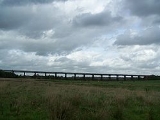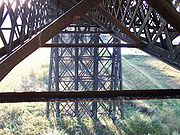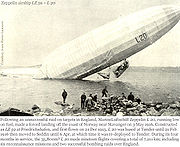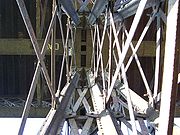
Bennerley Viaduct
Encyclopedia

Viaduct
A viaduct is a bridge composed of several small spans. The term viaduct is derived from the Latin via for road and ducere to lead something. However, the Ancient Romans did not use that term per se; it is a modern derivation from an analogy with aqueduct. Like the Roman aqueducts, many early...
spanning the Erewash Valley
Erewash Valley
The Erewash Valley is the valley of the River Erewash on the border of Derbyshire and Nottinghamshire as far as the River Trent. It runs along the boundary of the southern end of the Derbyshire hills and the more rolling Nottinghamshire country...
between Awsworth
Awsworth
Awsworth is a village and civil parish in the Broxtowe district of Nottinghamshire, England. It had a population of 2,266 in 2001. The village is near the edge of the Greater Nottingham area, between Kimberley and Ilkeston, Derbyshire....
in Nottinghamshire and Ilkeston
Ilkeston
Ilkeston is a town within the Borough of Erewash, in Derbyshire, England. It lies on the River Erewash, from which the local borough takes its name. Its population at the 2001 census was 37,550...
in Derbyshire.
Origins

Wrought iron
thumb|The [[Eiffel tower]] is constructed from [[puddle iron]], a form of wrought ironWrought iron is an iron alloy with a very low carbon...
lattice work
Lattice bridge
A lattice bridge is a form of truss bridge that uses a large number of small and closely spaced diagonal elements that form a lattice. It was patented by architect Ithiel Town in 1820 and 1835 as Town's lattice truss....
viaduct is 1452 feet long with the rails 60 feet 10 inches above the Erewash River
River Erewash
The River Erewash is a river in England that flows roughly southwards through Derbyshire, close to its eastern border with Nottinghamshire.-Etymology:...
. Most railway viaducts at the time were brick built but the foundations of the Bennerley Viaduct were subject to a great deal of coal mining subsidence therefore, the lighter wrought iron design was chosen. The viaduct was built between May 1876 and November 1877 and forms part of the Great Northern Railway Derbyshire Extension which was built in part to exploit the coalfields in Derbyshire
Derbyshire
Derbyshire is a county in the East Midlands of England. A substantial portion of the Peak District National Park lies within Derbyshire. The northern part of Derbyshire overlaps with the Pennines, a famous chain of hills and mountains. The county contains within its boundary of approx...
and Nottinghamshire
Nottinghamshire
Nottinghamshire is a county in the East Midlands of England, bordering South Yorkshire to the north-west, Lincolnshire to the east, Leicestershire to the south, and Derbyshire to the west...
. The contract was given by the Great Northern Railway
Great Northern Railway (Great Britain)
The Great Northern Railway was a British railway company established by the Great Northern Railway Act of 1846. On 1 January 1923 the company lost its identity as a constituent of the newly formed London and North Eastern Railway....
(GNR) to Benton & Woodiwiss with the line laid out by, and the viaduct designed by Richard Johnson (Chief Civil Engineer of the GNR); Samuel Abbott was the resident engineer. The viaduct consists of 16 lattice work deck spans
Span (architecture)
Span is the distance between two intermediate supports for a structure, e.g. a beam or a bridge.A span can be closed by a solid beam or of a rope...
, each 76 feet 7 inches long supported on wrought iron columns with stone capped blue brick foundations. There were three additional iron skew spans at the Ilkeston
Ilkeston
Ilkeston is a town within the Borough of Erewash, in Derbyshire, England. It lies on the River Erewash, from which the local borough takes its name. Its population at the 2001 census was 37,550...
end of the viaduct which carried the railway line over the Erewash Canal
Erewash Canal
The Erewash Canal is a broad canal in Derbyshire, England. It runs just under and has 14 locks. The first lock at Langley Bridge is actually part of the Cromford Canal.-Origins:...
and the Midland Railway
Midland Railway
The Midland Railway was a railway company in the United Kingdom from 1844 to 1922, when it became part of the London, Midland and Scottish Railway....
's Erewash Valley Line
Erewash Valley Line
The Erewash Valley Line is a railway line in Britain running from south of Chesterfield along the Erewash Valley to Trent Junction at Long Eaton, joining the Midland Main Line at each end.- History :...
. A skew span crosses its abutment
Abutment
An abutment is, generally, the point where two structures or objects meet. This word comes from the verb abut, which means adjoin or having common boundary. An abutment is an engineering term that describes a structure located at the ends of a bridge, where the bridge slab adjoins the approaching...
s and or piers
Pier (architecture)
In architecture, a pier is an upright support for a superstructure, such as an arch or bridge. Sections of wall between openings function as piers. The simplest cross section of the pier is square, or rectangular, although other shapes are also common, such as the richly articulated piers of Donato...
at an angle
Angle
In geometry, an angle is the figure formed by two rays sharing a common endpoint, called the vertex of the angle.Angles are usually presumed to be in a Euclidean plane with the circle taken for standard with regard to direction. In fact, an angle is frequently viewed as a measure of an circular arc...
other than a right angle
Angle
In geometry, an angle is the figure formed by two rays sharing a common endpoint, called the vertex of the angle.Angles are usually presumed to be in a Euclidean plane with the circle taken for standard with regard to direction. In fact, an angle is frequently viewed as a measure of an circular arc...
. At the Awsworth
Awsworth
Awsworth is a village and civil parish in the Broxtowe district of Nottinghamshire, England. It had a population of 2,266 in 2001. The village is near the edge of the Greater Nottingham area, between Kimberley and Ilkeston, Derbyshire....
end of the viaduct there was a section of embankment (including bridges of more conventional brick construction) which has been demolished. The Nottingham Canal
Nottingham Canal
The Nottingham Canal was a long canal between Langley Mill in Derbyshire and Nottingham, England. It opened in 1796, and most of it was closed in 1937. The southern section is now part of the River Trent Navigation, and the northern section is a nature reserve.-Origins:The idea for the canal first...
passed under this section. The viaduct was built for the railway line between Awsworth Junction
Awsworth
Awsworth is a village and civil parish in the Broxtowe district of Nottinghamshire, England. It had a population of 2,266 in 2001. The village is near the edge of the Greater Nottingham area, between Kimberley and Ilkeston, Derbyshire....
and Derby
Derby
Derby , is a city and unitary authority in the East Midlands region of England. It lies upon the banks of the River Derwent and is located in the south of the ceremonial county of Derbyshire. In the 2001 census, the population of the city was 233,700, whilst that of the Derby Urban Area was 229,407...
on the Derbyshire and Staffordshire Line and opened in January 1878. Bennerley Ironworks was originally due north of the viaduct served by sidings
Rail siding
A siding, in rail terminology, is a low-speed track section distinct from a running line or through route such as a main line or branch line or spur. It may connect to through track or to other sidings at either end...
connected to both the Great Northern line and the Midland Railway Erewash Valley line. After the demolition of the ironworks a British Coal
British Coal
thumb|right|British Coal company logoThe British Coal Corporation was a nationalised corporation in the United Kingdom responsible for the extraction of coal...
distribution depot served by sidings from the Midland Railway occupied the same site. This has now also been demolished.
Airship bombing raid

Zeppelin
A Zeppelin is a type of rigid airship pioneered by the German Count Ferdinand von Zeppelin in the early 20th century. It was based on designs he had outlined in 1874 and detailed in 1893. His plans were reviewed by committee in 1894 and patented in the United States on 14 March 1899...
airships of the German Airship Naval Division conducted a bombing raid over the British Midlands known as the Great Midlands Raid. One of these airships, the L.20 (LZ 59) based at Tønder
Tønder
Tønder is a municipality in Region of Southern Denmark on the Jutland peninsula in south Denmark. The municipality covers an area of 1,278 km², and has a total population of 40,367...
in Denmark
Denmark
Denmark is a Scandinavian country in Northern Europe. The countries of Denmark and Greenland, as well as the Faroe Islands, constitute the Kingdom of Denmark . It is the southernmost of the Nordic countries, southwest of Sweden and south of Norway, and bordered to the south by Germany. Denmark...
and commanded by KapitanLeutnant Stabbert conducted a bombing raid in the area around the Bennerley viaduct. Seven high explosive bombs were dropped in the vicinity, one of which dropped just to the north of the viaduct on the Midland Railway line at Bennerley Junction. Bennerley Junction served the Bennerley Ironworks sidings adjacent to the viaduct. Damage was caused to the Midland line but the viaduct emerged unscathed. Later during the same raid the L.20 dropped fifteen bombs onto the nearby Stanton Ironworks one of which damaged a railway bridge crossing the Nutbrook Canal
Nutbrook Canal
The Nutbrook Canal was a canal in England which ran between Shipley, Derbyshire and the Erewash Canal, joining it near Trowell. It was built to serve the collieries at Shipley and West Hallam, and was completed in 1796. It was initially profitable, but from 1846 faced competition from the railways,...
. On May 4, 1916 after a second air raid over England the L.20 ran out of fuel and crashlanded near Stavanger
Stavanger
Stavanger is a city and municipality in the county of Rogaland, Norway.Stavanger municipality has a population of 126,469. There are 197,852 people living in the Stavanger conurbation, making Stavanger the fourth largest city, but the third largest urban area, in Norway...
in Norway
Norway
Norway , officially the Kingdom of Norway, is a Nordic unitary constitutional monarchy whose territory comprises the western portion of the Scandinavian Peninsula, Jan Mayen, and the Arctic archipelago of Svalbard and Bouvet Island. Norway has a total area of and a population of about 4.9 million...
.
Giltbrook Viaduct
At Awsworth Junction the railway branched, one line passed over the Bennerley Viaduct as described, the other turned North towards PinxtonPinxton
Pinxton is a village on the eastern boundary of Derbyshire in the Bolsover district, England.In Anglo-Saxon times it was a small agricultural community, thought to have been recorded in the Domesday Book as "Esnotrewic." It is also thought that it was known as "Snodeswic," given by Wulfric Spott to...
crossing the Giltbrook Viaduct
Giltbrook Viaduct
Giltbrook Viaduct was a railway viaduct built in the Erewash Valley between Awsworth and Giltbrook in Nottinghamshire. It was demolished in 1973 to make way for the A610 bypass.-Origins:...
(or Kimberley Viaduct but known locally as Forty Bridges). This viaduct was also designed by Richard Johnson and built of red bricks used to create 43 arched spans with a total length of 1716 feet and a height of 60 feet.
Other wrought iron viaducts


- The only similar viaduct in the United Kingdom was the Halesowen Joint RailwayHalesowen Joint RailwayThe Halesowen Joint Railway was a British pre-grouping railway company that opened a six mile line in 1883 in the Midlands. It later became a joint railway owned by the Midland Railway and the Great Western Railway....
's Dowery DellDowery DellDowery Dell, near Hunnington in Worcestershire, was notable for a cast iron railway viaduct that carried the Halesowen to Longbridge railway until it was dismantled in 1964....
(HunningtonHunningtonHunnington is a village and civil parish in the Bromsgrove District of Worcestershire, England, close to the border with West Midlands, and just south of Halesowen. According to the 2001 census the parish had a population of 552...
or Frankley) Viaduct demolished in 1964. Other apparently similar structures were usually Warren TrussTruss bridgeA truss bridge is a bridge composed of connected elements which may be stressed from tension, compression, or sometimes both in response to dynamic loads. Truss bridges are one of the oldest types of modern bridges...
es, or (as in the case of Kew Railway Bridge), supported on cast iron cylindrical columns rather than wrought iron piers. - The first Tay Rail BridgeTay Rail BridgeThe Tay Bridge is a railway bridge approximately two and a quarter miles long that spans the Firth of Tay in Scotland, between the city of Dundee and the suburb of Wormit in Fife ....
used a similar latticework design. It collapsed during a storm in 1879 with the loss of 75 lives. - One other wrought iron railway viaduct still stands in Britain. This is the Meldon Viaduct consisting of six, 90 feet (27.4 m) long Warren trussTruss bridgeA truss bridge is a bridge composed of connected elements which may be stressed from tension, compression, or sometimes both in response to dynamic loads. Truss bridges are one of the oldest types of modern bridges...
spans with a total length of 540 feet (164.6 m), 120 feet (36.6 m) above the valley floor built for the London and South Western RailwayLondon and South Western RailwayThe London and South Western Railway was a railway company in England from 1838 to 1922. Its network extended from London to Plymouth via Salisbury and Exeter, with branches to Ilfracombe and Padstow and via Southampton to Bournemouth and Weymouth. It also had many routes connecting towns in...
in 1874. - The dismantled Crumlin Viaduct finished in 1857 consisted of ten, 150 feet (45.7 m) long Warren Truss Spans 200 feet (61 m) above the valley floor built for the Taff Vale Railway extensionNewport, Abergavenny and Hereford RailwayThe Newport, Abergavenny and Hereford Railway was a railway line connecting the Welsh port city of Newport via Abergavenny, to the major English market town of Hereford.Sponsored by the LNWR, it opened on 6 December 1853...
. This was the tallest viaduct in Great Britain until its demolition in 1965. This viaduct was used as a film location during its demolition whilst filming ArabesqueArabesque (film)Arabesque is a 1966 thriller starring Gregory Peck and Sophia Loren. The movie is based on Gordon Cotler's novel The Cypher and directed by Stanley Donen.-Plot:Professor David Pollock is an expert in ancient hieroglyphics at Oxford University...
. - The dismantled Belah Viaduct finished in 1861 consisted of 16 spans with a total length of 1040 feet (317 m), 196 feet (59.7 m) above the valley floor, built for the South Durham and Lancashire Union Railway. This was the tallest viaduct in England. It was closed in 1962.
- A wrought iron viaduct was built at West MeonWest MeonWest Meon is a small village in Hampshire, England, with a population of 690.It is situated near to Petersfield and East Meon, on the headwaters of the River Meon....
on the Meon Valley RailwayMeon Valley RailwayThe Meon Valley Railway was a cross-country railway in Hampshire, England that ran for between Alton and Fareham, closely following the course of the River Meon. At its northern end, it joined with the Mid-Hants Railway to Winchester, the Alton Line to Brookwood and the Basingstoke and Alton...
, opened in 1903. This 4-span viaduct stood 62 feet (18.9 m) high. Built to carry double track, the viaduct only ever carried a single line. The viaduct was demolished in 1955, and only the concrete pedestals and foundations remain. - The Staithes Viaduct built for the Whitby Redcar and Middlesbrough Union RailwayWhitby Redcar and Middlesbrough Union RailwayThe Whitby, Redcar and Middlesbrough Union Railway was a short lived railway line, running along the northeast coast of England from the River Tees at Middlesbrough to the Esk at Whitby, where it met the Scarborough & Whitby Railway line and the Whitby and Pickering Railway...
in 1875 and opened in 1883 was of wrought iron construction. It was dismantled in 1960.
After closure

Demolition
Demolition is the tearing-down of buildings and other structures, the opposite of construction. Demolition contrasts with deconstruction, which involves taking a building apart while carefully preserving valuable elements for re-use....
. The demolition contractors who tendered for the contract to demolish the viaduct put forward amounts which were considered too high. The reason given for the high cost was that wrought iron
Wrought iron
thumb|The [[Eiffel tower]] is constructed from [[puddle iron]], a form of wrought ironWrought iron is an iron alloy with a very low carbon...
structures could not be cut up with an oxy-acetylene torch and would have to be taken apart rivet by rivet. The viaduct survived to become a grade II* listed structure.
The Meldon Viaduct was refurbished in 1996 and is now part of the Granite Way cycle and footpath in Devon.
Bennerley Viaduct is managed by Sustrans
Sustrans
Sustrans is a British charity to promote sustainable transport. The charity is currently working on a number of practical projects to encourage people to walk, cycle and use public transport, to give people the choice of "travelling in ways that benefit their health and the environment"...
and may yet be used in the future as part of the national foot and cyclepath network in a similar way to the Meldon Viaduct. It is on the Buildings at Risk Register.

